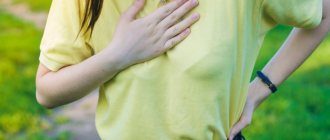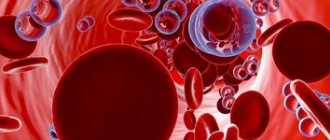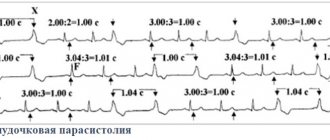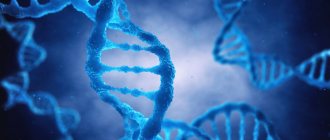Characteristic symptoms
Shortness of breath with coronavirus: how to understand ? It is difficult for the patient to take a deep breath. He makes at least twenty respiratory movements, which is typical for the moderate severity of the disease. As for the severe degree, it is characterized by more than thirty respiratory movements per minute.
At the same time, severe inflammatory processes occur in the lungs: a person’s body temperature rises, but in some situations, shortness of breath with coronavirus without fever , a dry cough is bothersome. But in some cases there may be no symptoms. Then the cough is caused by fear and panic.
If pneumonia is present, during auscultation the doctor hears whistling and wheezing in the bronchi. This is often typical for patients with concomitant bronchial asthma, chronic bronchitis and in the presence of secondary lung damage. Subsequently, if treatment is not timely, edema of the pulmonary tissue may develop - this is a life-threatening condition.
Stopping intermittent breathing
Doctors at the Yusupov Hospital treat breathing disorders due to VSD with sedatives, physical exercise, and psychotraining. During training sessions, psychologists try to teach the patient how to properly cope with a stressful situation. If the patient is simply very worried, take sedative medications - valerian, novo-passit, motherwort. If the patient has ever suffered a panic attack or has previously been diagnosed with neurosis, neurologists use tranquilizers, antipsychotics, and nootropic drugs. In severe cases, cyclic antidepressants are prescribed.
To relieve an attack of suffocation during VSD, the patient should be seated and calmed down. The patient needs rest. It is necessary to unfasten the compressive elements of clothing and ventilate the room. If this does not help, the patient needs a motherwort or valerian tablet. If there is information about a panic attack or neurosis, you must immediately give the medicine previously prescribed by a psychiatrist.
What are the characteristics of breathing complications after suffering from covid-19?
Symptoms of shortness of breath with coronavirus:
- feeling of tightness in the chest,
- rapid breathing,
- superficial breathing movements,
- It's difficult to take a deep breath.
coronavirus shortness of breath symptoms
The presence of shortness of breath in healthy people does not always indicate pathology. It can normally occur in athletes and runners. It can also occur in ordinary people during physical activity. But after suffering from covid-19, shortness of breath occurs even at rest, the body is starved of oxygen, which disrupts its vital functions.
4.Treatment
Therapy is always aimed at eliminating the underlying disease, or, if its course is chronic, at relieving the main symptoms and achieving high-quality remission. Dyspnea at rest practically never occurs as a single and isolated symptom; Given the sufficient specificity of the associated symptom complexes, the root cause can usually be determined quickly, after which adequate specialized treatment is prescribed.
It is important, however, to repeat: shortness of breath at rest is one of the alarming symptoms, and most often it is a sign (sometimes the first) of a very serious pathology that requires immediate examination and intervention. Therefore, the appearance of this type of respiratory disorder should be a reason for an urgent visit to the doctor.
Sign up for a consultation
What types of shortness of breath are there after coronavirus?
Doctors distinguish two types of shortness of breath after coronavirus , which occur in patients in this group:
- Emerging gradually. A person feels difficulty during inhalation and exhalation not only during exercise, but also at rest. Worsening occurs at night, and signs of suffocation may occur. When you raise your arms up, the patient's condition is better.
- Sudden shortness of breath. It occurs against a background of complete well-being and is accompanied by headache and sweating. It is impossible to take a full breath, the fear of death arises.
Both options require emergency medical attention. Because at any moment the patient’s condition may worsen and breathing will become impossible. Now you know what shortness of breath is like with coronavirus .
Not enough air - treatment methods
If it is difficult to breathe for physiological reasons, but there are no diseases, no special therapy is required. Many people are interested in what to do if breathing is a little difficult, but there are no serious disorders in the body. To improve your well-being, you should use simple methods (ventilation, humidification, taking sedatives, agreed with the doctor).
Patients who have difficulty breathing due to certain diseases are prescribed complex treatment. Main goals of therapy:
- eliminate foci of infection and inflammation;
- clear the airways;
- speed up the discharge of sputum;
- improve blood composition;
- stabilize the functioning of the heart muscle;
- normalize the condition of blood vessels.
To eliminate lack of air during breathing, specialists at the KRH Dental & Medical clinic use effective and safe medications and prescribe effective procedures. Each patient is guaranteed attentive attention and an individual approach. After the treatment is completed, recommendations are given to correct the lifestyle and prevent the recurrence of the pathology.
How to assess lung function after coronavirus?
A breath test should be performed. You can do it yourself at home:
- take a deep breath through your nose,
- hold your breath for ten seconds,
- exhale slowly.
In the absence of any discomfort, cough or sore throat, the lungs are healthy. If your health worsens and these symptoms occur, you should immediately seek medical help. You can find a video on the forum on how to properly do a lung assessment.
Lack of air with VSD
One of the common manifestations of VSD is a feeling of lack of air or hyperventilation of the lungs. At the same time, you may feel a “lump in your throat,” increased breathing, and you experience a feeling of lack of oxygen. It is actually a condition in which there is not enough carbon dioxide in the blood. The body begins to give a command to slow down your breathing, and if you are prone to anxiety, you instinctively begin to breathe more often.
Along with the lack of air, accompanying symptoms may appear - rapid heartbeat, ringing in the ears, tingling in the limbs.
Attacks are especially active during stressful conditions.
Self-diagnosis problems
Difficulty breathing, for example, during nasal congestion and when the functioning of the lungs is impaired, are completely different things. It is impossible to figure out the cause of shortness of breath on your own.
treatment of shortness of breath due to coronavirus
You should seek medical help from your family doctor or pulmonologist. You should not self-medicate.
Treatment of shortness of breath after suffering from covid-19
Shortness of breath after coronavirus, what to do ? If you have difficulty taking a deep breath, after additional diagnostics, doctors prescribe:
- drug therapy,
- oxygen therapy,
- inhalations,
- physiotherapy,
- breathing exercises.
Later in the article we will talk in more detail about each treatment method.
Medicines for shortness of breath
Many people are interested in the question: how to treat shortness of breath with coronavirus ? To relieve symptoms, doctors prescribe drugs from the following groups:
- bronchodilators,
- expectorants,
- antiviral drugs,
- immunomodulators,
- antibacterial drugs.
The doctor selects the drug and its dosage individually depending on the severity of the symptoms, the clinical picture and the presence of concomitant pathology in the individual patient.
Oxygen therapy (oxygenation)
It is an oxygen inhalation, which is used in case of shortness of breath without coronavirus . Oxygen is introduced into a person's respiratory tract using a special tube.
Oxygenation is used only in patients with severe forms of pathology, with extensive lung damage. If all medical recommendations are followed, the risk of such complications is minimal.
Inhalation therapy
It is used using a Nebulizer, which allows you to administer drugs in the form of microparticles dissolved in the air into the patient’s respiratory tract. A good effect can be achieved by using:
- phlegm thinners,
- sea water,
- saline solutions,
- antiseptics,
- bronchodilators,
- expectorants.
This method should be used only as prescribed by a doctor so as not to harm the functioning of the lungs.
Physiotherapy
In order to accelerate the resorption of pathological foci and relieve inflammation after suffering from covid-19, the following should be carried out:
- chest massage,
- electrophoresis,
- SMT,
- UHF therapy.
Please note that you should complete the full course of procedures to achieve a good treatment result.
Breathing exercises
It is worth doing the exercise both during the disease itself and after it has been cured and a negative test has been received. These exercises will strengthen your chest muscles and increase blood flow to your lungs.
Can I improve my lung function on my own?
Can! There are quite simple methods for this:
- It is necessary to consume fresh vegetables and fruits as much as possible. Tomatoes, blueberries, nuts, onions and citrus fruits are especially beneficial for the lungs. Fatty foods, spices and smoked foods should be avoided.
- You shouldn't smoke. Tobacco smoke provokes the occurrence of inflammatory diseases, while the resistance of the lungs to viral and bacterial pathologies weakens. The relationship between tobacco smoke and the occurrence of cancer has also been proven. To speed up the process of recovery of lung tissue, you should abstain from smoking.
- Cardio exercise (this can be jogging at a moderate speed, walking at speed, jumping rope). They should be performed if you feel well. They help strengthen the heart muscle, normalize blood circulation, increase the respiratory volume of the lungs and build endurance. Training should be done outdoors. Increase the load gradually. If you feel the slightest deterioration in health, the training should be interrupted.
- Eliminate negative environmental factors and smoke. After suffering from covid-19 with accompanying symptoms ( shortness of breath, coronavirus pneumonia ) in the early period after the disease, you should not be in polluted conditions. If there are harmful professional conditions, it is better to take a vacation. Spend more time outdoors, ideally visit a sanatorium or health resort in a pine forest or on the seashore.
Anyone who listens to the doctor’s recommendations, takes medications on time, eats right, engages in dosed physical activity and walks in the fresh air will quickly get rid of the consequences of covid-19. Be attentive to your health and seek specialized medical help when the first symptoms of illness appear.
Causes of shortness of breath
Shortness of breath is caused by various reasons. The most common causes of shortness of breath are:
- diseases of the cardiovascular system
. Cardiovascular pathologies lead to insufficient blood circulation. The organs do not receive the required amount of oxygen, and carbon dioxide accumulates in the blood. The body reacts to this condition by breathing faster - more air is pumped through the lungs per unit of time. Shortness of breath due to cardiac pathology occurs or worsens after physical exertion or while lying down. In a sitting or semi-sitting position, shortness of breath goes away. This type of shortness of breath is characterized by difficulty breathing; - pathologies of the respiratory system
. Shortness of breath may be caused by obstructions to the passage of air through the respiratory tract, for example, by narrowing of the lumens of the bronchi. Therefore, shortness of breath is a typical symptom of bronchial asthma. In this case, exhalation is difficult. Shortness of breath can also be caused by a decrease in the respiratory surface of the lung tissue. As a result of such a decrease, in order to maintain the required amount of oxygen entering the blood, more intensive work of the lungs is required, that is, more frequent inhalation. The list of diseases of the respiratory system in which shortness of breath may occur is extensive and includes such dangerous pathologies as tumors, pneumonia, chronic obstructive pulmonary diseases and others; - anemia
. A lack of red blood cells (erythrocytes) and hemoglobin leads to the fact that even with normal functioning of the heart and lungs, the blood is not able to provide the organs with the necessary amount of oxygen, and the body tries to compensate for this by increasing the breathing rate; - neuroses and panic attacks
. In this case, a clinical examination does not reveal pathologies of the heart and lungs, but subjectively the patient experiences a lack of air, and psycho-emotional changes lead to increased breathing. - Obesity and diabetes also often lead to shortness of breath.











